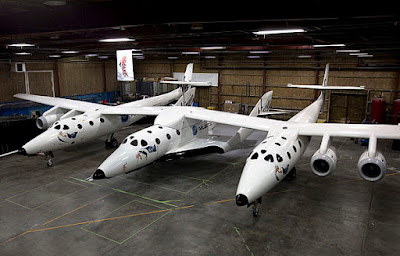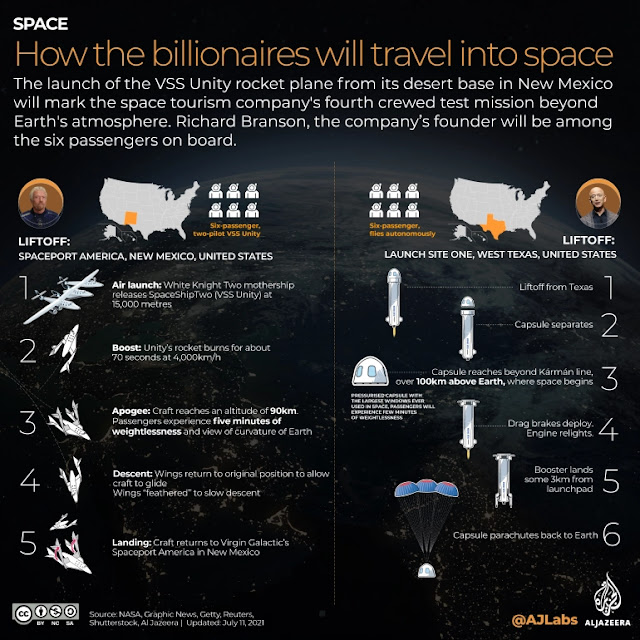The Second Space Race
July has been a big month for commercial space companies. SpaceX did a test fire for the main Starship Booster. Relativity Space announced that it was building a new factory in Long Beach to help scale up Terran R production. And Rocket Labs is working on a contract from NASA to create satellites to study Mars’s atmosphere. But, Virgin Galactic and Blue Origin did something that only SpaceX has been able to achieve: send civilians into space.
 |
| Virgin Galactic's SpaceShip 2 (Left) Blue Origin's New Shepard (Right) |
 |
| BE-4 Rocket Engine Developed By Blue Origin |
 |
| Blue Origin Crew for July 20th Flight (From Left to Right): Oliver Daeman, Wally Funk, Jeff Bezos, Mark Bezos |
Eventually, after 15 launches on July 20, 2021, New Shepard launched with 4 passengers: Jeff Bezos, his brother Mark Bezos, Wally Funk (the oldest person to go into space), and Oliver Daemen (the youngest person to go into space).
On the other hand, there is Virgin Galactic. Virgin Galactic was founded by Richard Branson in 2004 and was a part of the Virgin group. Virgin Galactic’s main goal was always to make space tourism a thing by making it cheaper and more normal. Virgin Galactic’s approach was very different from Blue Origin. While Blue Origin used a traditional rocket, Virgin Galactic used a carrier plane to launch a smaller plane that would have an incredibly strong engine to help propel it into space. The carrier plane is called the White Knight Two(WK2), which is a large fixed-wing aircraft. It looks like two planes joined at the wing. White Knight Two is also a part of the Virgin Orbit Company, another company under the Virgin group which uses planes to lift rockets higher into the atmosphere and launch them. Branson hopes that this can be used to launch satellites into LEO for cheaper.
 |
| SpaceShip 2 on Descent |
Now, let's talk about the two vehicles. First, there is New Shepard from Blue Origin. The New Shepard (NS) is Blue Origin’s suborbital launch vehicle developed for suborbital space tourism. Prototypes of the launch vehicle and its engine date back all the way to 2006. In 2010, Blue Origin started working on the NS vehicle engine and finished its development cycle in 2015. The NS vehicle uses the BP-3PM liquid rocket engine, which has 110,000 lbf (489 kN) of thrust.
 |
| New Shepard Launch in 2015 |
 |
| SpaceShipTwo (Center) Attached to White Knight Two (Left and Right) |
 |
| Virgin Galactic Crew on July 11th Flight (From Left to Right): Dave Mackay, Colin Bennet, Beth Moses, Richard Branson, Sirisha Bandla, Michael Masucci |
Both of the flights barely passed the Karmen Line, which is considered the boundary of space. And both of the crews weren't considered astronauts by the FAA. But both of these flights showed how technology and how the modern space race is evolving. Every year, there are more and more aerospace companies in the United States. In fact, in 2019, the space industry had an average growth rate of 10.6% and was valued at $424 billion. However, due to the rapid increase in private space companies, the Bank of America forecasted that by 2030, the industry’s revenue will grow by 230% and be about $1.4 trillion. And in the next decade, we will see more and more companies approach space tourism as a business model, but this could be troubling for humanity.
 |
| How and Where Both Flights Occurred |
Rocket launches do a lot of damage to the atmosphere because they burn fuel in the highest parts of the atmosphere. This damages the ozone layer and may contribute greatly to climate change. The reason this issue hasn’t been a huge contributor to climate change was that rocket launches were very infrequent. However, with the growing number of launches, the issue is bound to be a bigger problem. To tackle this some companies are creating biofuel, like BuShift Aerospace. To learn more about them, check out this article. Another issue that is already a huge problem is space debris. Space debris is any defunct or broken manmade object orbiting the Earth.
 |
| Model Showing Space Debris in LEO |
Ultimately, we are in the second coming of the space race. While the Space Race was a competition between the USSR and the United States, this new space race is a competition between companies and which company will succeed. We already have major competitors in this space race like SpaceX, Blue Origin, and Virgin Galactic. But more and more companies will enter the race. While there are many pros to this, there are also negatives that can affect the world greatly. Only time will tell how we will perceive this space race.
Sources:
Alamalhodaei, Aria. “Relativity Space Will Open a 1 Million Square Foot Factory to Scale TERRAN r Production.” TechCrunch, TechCrunch, 30 June 2021, techcrunch.com/2021/06/30/relativity-space-will-open-a-1-million-square-foot-factory-to-scale-terran-r-production/?guccounter=1&guce_referrer=aHR0cHM6Ly93d3cuZ29vZ2xlLmNvbS8&guce_referrer_sig=AQAAANRDqXmtejlxCbmkz5lPgqEyn1Db79-29Q4jMGzLmjCEcNVHbLSOkV6Ixdstdn966cCEPaBScoHznbN28bXiM1MqCz23KakMqc7FffmRlNMokNOjXfDuGXdHZ1jKAR1Zu9uFk4Hg4KM-lxqzaDBydEaCAaHjT-f3nyRBboELkQwl.
“Blue Origin.” Wikipedia, Wikimedia Foundation, 26 July 2021, en.wikipedia.org/wiki/Blue_Origin.
Caitlin, Caitlin. “Bezos and His Blue ORIGIN Crewmates Trained for 14 Hours. These Are the Requirements They Had to Meet.” CBS News, CBS Interactive, 20 July 2021, www.cbsnews.com/news/blue-origin-crew-training-space-flight/.
Chughtai, Alia. “Infographic: Billionaire Space Tourism.” Infographic News | Al Jazeera, Al Jazeera, 11 July 2021, www.aljazeera.com/news/2021/7/11/infographic-billionaire-space-tourism-interactive.
“Cruciform Tail.” Wikipedia, Wikimedia Foundation, 13 May 2021, en.wikipedia.org/wiki/Cruciform_tail.
Edwards, Charlotte. “Blue Origin New SHEPARD vs Virgin Galactic: How Do the Two SPACESHIPS COMPARE.” The Sun, The Sun, 20 July 2021, www.thesun.co.uk/tech/15544239/virgin-galactic-vs-blue-origin/.
Fingas, Jon. “Virgin Galactic Delays Space TOURISM Flights to Early 2022.” Engadget, 26 Feb. 2021, www.engadget.com/virgin-galactic-delays-space-tourism-flights-2022-140906661.html.
Garcia, Mark. “Space Debris and Human Spacecraft.” NASA, NASA, 14 Apr. 2015, www.nasa.gov/mission_pages/station/news/orbital_debris.html.
“Home.” Blue Origin, 26 July 2021, www.blueorigin.com/.
“LauncherOne.” Wikipedia, Wikimedia Foundation, 2 July 2021, en.wikipedia.org/wiki/LauncherOne.
Malik, Tariq. “SpaceX Test Fires Massive Super Heavy Booster for Starship for 1st Time (Video).” Space.com, Space, 20 July 2021, www.space.com/spacex-starship-super-heavy-rocket-booster-engine-test.
Payne, Miriam. “The Modern Space Race.” TheGIST, 25 Nov. 2012, the-gist.org/2020/06/the-modern-space-race/.
Pradhan, Arnav. “Did You Know Jeff Bezos Is in Space (Well, His Rockets Are)?” Did You Know Jeff Bezos Is in Space (Well, His Rockets Are)?, Blogger, 25 Feb. 2021, www.theaceofspace.org/2021/01/did-you-know-jeff-bezos-is-in-space.html.
Pradhan, Arnav. “The Dangers of the Debris.” The Dangers of the Debris, Blogger, 9 Apr. 2021, www.theaceofspace.org/2021/02/the-dangers-of-debris.html.
Pradhan, Arnav. “You Have Heard of Biofuel Cars, but Have You Heard of Biofuel Rockets?” You Have Heard of Biofuel Cars, But Have You Heard of Biofuel Rockets?, Blogger, 25 Feb. 2021, www.theaceofspace.org/2021/01/you-have-heard-of-biofuel-car-but-have.html.
“Rocket Launches Could Be Affecting Our Ozone Layer, Say Experts | CBC News.” CBCnews, CBC/Radio Canada, 23 Apr. 2021, www.cbc.ca/news/science/rocket-launches-environment-1.5995252.
“Scaled Composites White Knight Two.” Wikipedia, Wikimedia Foundation, 5 Feb. 2021, en.wikipedia.org/wiki/Scaled_Composites_White_Knight_Two.
“Spaceshiptwo.” Wikipedia, Wikimedia Foundation, 19 July 2021, en.wikipedia.org/wiki/SpaceShipTwo#Design_overview.
Thesheetztweetz. “Bank of America Expects the Space Industry to Triple to a $1.4 Trillion Market within a Decade.” CNBC, CNBC, 4 Oct. 2020, www.cnbc.com/2020/10/02/why-the-space-industry-may-triple-to-1point4-trillion-by-2030.html.
Thesheetztweetz. “Rocket Lab WINS NASA Contract for Mars Spacecraft as Interplanetary Missions Become Less Costly.” CNBC, CNBC, 15 June 2021, www.cnbc.com/2021/06/15/rocket-lab-wins-nasa-contract-for-mars-escapade-spacecraft.html.
“Virgin Galactic Announces First Fully Crewed Spaceflight.” Virgin Galactic, www.virgingalactic.com/articles/virgin-galactic-announces-first-fully-crewed-spaceflight/.
“Virgin Galactic.” Virgin Galactic, www.virgingalactic.com/.
“Virgin Galactic.” Wikipedia, Wikimedia Foundation, 28 July 2021, en.wikipedia.org/wiki/Virgin_Galactic#Notable_accomplishments.
“Virgin Orbit.” Wikipedia, Wikimedia Foundation, 20 July 2021, en.wikipedia.org/wiki/Virgin_Orbit.
“Vss Enterprise.” Wikipedia, Wikimedia Foundation, 12 July 2021, en.wikipedia.org/wiki/VSS_Enterprise.
“VSS Unity.” Wikipedia, Wikimedia Foundation, 21 July 2021, en.wikipedia.org/wiki/VSS_Unity#Test_flight_program.



Comments
Post a Comment